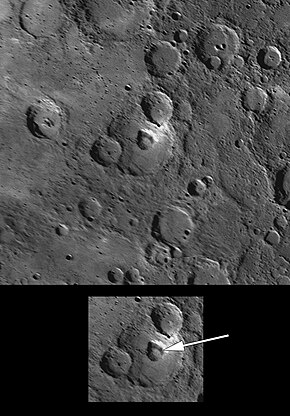Gibran is a crater on Mercury and is in the east of the Shakespeare quadrangle. It was named after Lebanese-American poet Khalil Gibran in 2009.[1] Gibran is located east of the rayed crater of Degas and nearby Damer.
 Arrow indicates pit crater within Gibran | |
| Planet | Mercury |
|---|---|
| Coordinates | 35°44′N 111°26′W / 35.73°N 111.44°W |
| Quadrangle | Shakespeare |
| Diameter | 106 km (66 mi)[1] |
| Eponym | Khalil Gibran[1] |
The crater was discovered by the Mariner 10 spacecraft in 1974, but was not named until 2009. It contains a large (29 × 29 km), nearly circular pit crater.[2] Multiple examples of pit craters have been observed on Mercury on the floors of impact craters, leading to the name pit-floor craters for the impact structures that host these features (see also Beckett and Picasso). Unlike impact craters, pit craters are rimless, often irregularly shaped, steep-sided, and often display no associated ejecta or lava flows.[2] These pit craters are thought to be evidence of shallow volcanic activity and may have formed when retreating magma caused an unsupported area of the surface to collapse, creating a pit. They are analogs of Earth's volcanic calderas.[2] Pit-floor craters may provide an indication of internal igneous processes where other evidence of volcanic processes is absent or ambiguous. The discovery of multiple pit-floor craters augments evidence that volcanic activity has been a widespread process in the geologic evolution of Mercury's crust.[3]
Views edit
-
Mariner 10 image with Gibran at bottom center
-
Approximate color image by MESSENGER
References edit
- ^ a b c "Gibran (crater)". Gazetteer of Planetary Nomenclature. USGS Astrogeology Research Program.
- ^ a b c Gillis-Davis, Jeffrey J.; Blewett, David T.; Gaskell, Robert W.; Denevi, Brett W.; Robinson, Mark S.; Strom, Robert G.; Solomon, Sean C.; Sprague, Ann L. (2009). "Pit-floor craters on Mercury: Evidence of near-surface igneous activity". Earth and Planetary Science Letters. 285 (3–4): 243–250. Bibcode:2009E&PSL.285..243G. doi:10.1016/j.epsl.2009.05.023. See unnamed feature 2.
- ^ "Picture of a Pit-Floor Crater". JHU/APL. July 21, 2009. Archived from the original on April 2, 2015. Retrieved November 20, 2009.